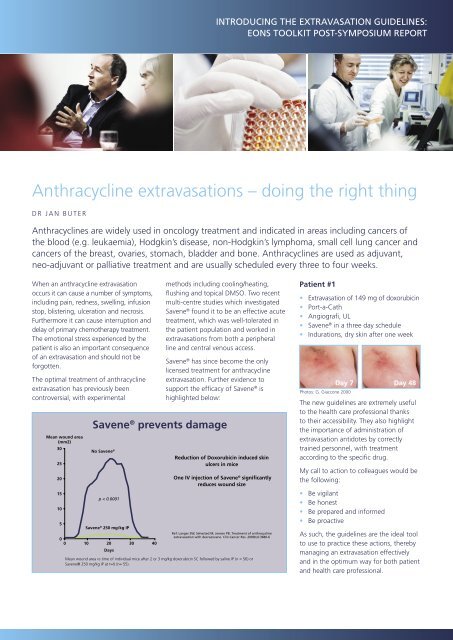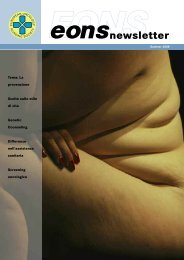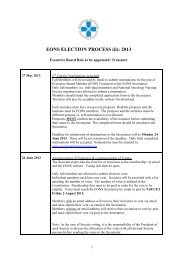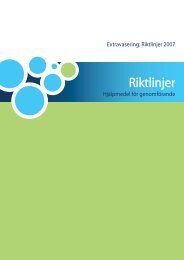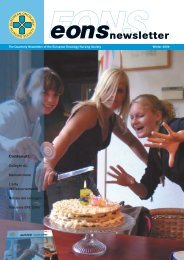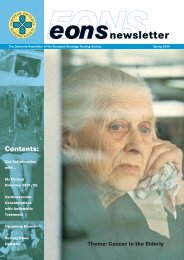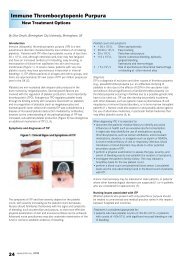Introducing the Extravasation Guidelines - the European Oncology ...
Introducing the Extravasation Guidelines - the European Oncology ...
Introducing the Extravasation Guidelines - the European Oncology ...
You also want an ePaper? Increase the reach of your titles
YUMPU automatically turns print PDFs into web optimized ePapers that Google loves.
INTRODUCING THE EXTRAVASATION GUIDELINES:<br />
EONS TOOLKIT POST-SYMPOSIUM REPORT<br />
Anthracycline extravasations – doing <strong>the</strong> right thing<br />
D R JAN BUTER<br />
Anthracyclines are widely used in oncology treatment and indicated in areas including cancers of<br />
<strong>the</strong> blood (e.g. leukaemia), Hodgkin’s disease, non-Hodgkin’s lymphoma, small cell lung cancer and<br />
cancers of <strong>the</strong> breast, ovaries, stomach, bladder and bone. Anthracyclines are used as adjuvant,<br />
neo-adjuvant or palliative treatment and are usually scheduled every three to four weeks.<br />
When an anthracycline extravasation<br />
occurs it can cause a number of symptoms,<br />
including pain, redness, swelling, infusion<br />
stop, blistering, ulceration and necrosis.<br />
Fur<strong>the</strong>rmore it can cause interruption and<br />
delay of primary chemo<strong>the</strong>rapy treatment.<br />
The emotional stress experienced by <strong>the</strong><br />
patient is also an important consequence<br />
of an extravasation and should not be<br />
forgotten.<br />
The optimal treatment of anthracycline<br />
extravasation has previously been<br />
controversial, with experimental<br />
Mean wound area<br />
(mm2)<br />
30<br />
25<br />
20<br />
15<br />
10<br />
5<br />
methods including cooling/heating,<br />
flushing and topical DMSO. Two recent<br />
multi-centre studies which investigated<br />
Savene ® found it to be an effective acute<br />
treatment, which was well-tolerated in<br />
<strong>the</strong> patient population and worked in<br />
extravasations from both a peripheral<br />
line and central venous access.<br />
Savene ® has since become <strong>the</strong> only<br />
licensed treatment for anthracycline<br />
extravasation. Fur<strong>the</strong>r evidence to<br />
support <strong>the</strong> efficacy of Savene ® is<br />
highlighted below:<br />
Savene ® prevents damage<br />
No Savene ®<br />
p < 0.0001<br />
Savene ® 250 mg/kg IP<br />
0<br />
0 10 20 30 40<br />
Days<br />
Reduction of Doxorubicin induced skin<br />
ulcers in mice<br />
One IV injection of Savene ® significantly<br />
reduces wound size<br />
Ref: Langer SW, Sehested M, Jensen PB. Treatment of anthracycline<br />
extravasation with dexrazoxane. Clin Cancer Res. 2000b;6:3680-6<br />
Mean wound area vs time of individual mice after 2 or 3 mg/kg doxorubicin SC followed by saline IP (n = 56) or<br />
Savene® 250 mg/kg IP at t=0 (n= 55).<br />
Patient #1<br />
• <strong>Extravasation</strong> of 149 mg of doxorubicin<br />
• Port-a-Cath<br />
• Angiografi, UL<br />
• Savene ® in a three day schedule<br />
• Indurations, dry skin after one week<br />
Photos: G. Giaccone 2000<br />
Day 7 Day 48<br />
The new guidelines are extremely useful<br />
to <strong>the</strong> health care professional thanks<br />
to <strong>the</strong>ir accessibility. They also highlight<br />
<strong>the</strong> importance of administration of<br />
extravasation antidotes by correctly<br />
trained personnel, with treatment<br />
according to <strong>the</strong> specific drug.<br />
My call to action to colleagues would be<br />
<strong>the</strong> following:<br />
• Be vigilant<br />
• Be honest<br />
• Be prepared and informed<br />
• Be proactive<br />
As such, <strong>the</strong> guidelines are <strong>the</strong> ideal tool<br />
to use to practice <strong>the</strong>se actions, <strong>the</strong>reby<br />
managing an extravasation effectively<br />
and in <strong>the</strong> optimum way for both patient<br />
and health care professional.


